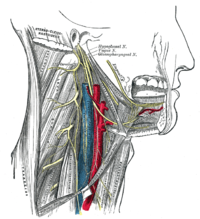
Photo from wikipedia
STUDY OBJECTIVE To provide an analysis of closed malpractice claims brought against anesthesiologists for positioning-related perioperative nerve injury (PRPNI). DESIGN In this retrospective study, we analyzed closed claims data from… Click to show full abstract
STUDY OBJECTIVE To provide an analysis of closed malpractice claims brought against anesthesiologists for positioning-related perioperative nerve injury (PRPNI). DESIGN In this retrospective study, we analyzed closed claims data from the Controlled Risk Insurance Company (CRICO) Comparative Benchmarking System (CBS) database. SETTING Closed claims involving nerve injuries that occurred between January 1, 1996 and December 31, 2015 in all surgical settings, provided the alleged damaging event occurred under general anesthesia. PATIENTS Patient ages ranged from 23 to 94. Patients underwent a variety of surgical procedures. Severity of nerve injury ranged from "Insignificant" to "Grave" according to the NAIC Severity of Injury Code. INTERVENTIONS None. MEASUREMENTS Patient age and gender, alleged nerve injury type and severity, operating surgical specialty, contributing factors to the alleged nerve injury, and case outcome. Some of these data were drawn directly from coded variables in the CBS database, and some were gathered by the authors from CRICO-encoded narrative case summaries. MAIN RESULTS Seventy-five claims were determined to represent PRPNI. Ninety-two percent of all PRPNI claims involved practitioner technical knowledge/performance. Of all the recorded nerve injuries in this series, 56% involved brachial plexus injuries, and supine patient positioning represented 55% of brachial plexus claims. Settlement payments were made in 33% of claims, and the average payment for all cases was $46,269. Twenty-four percent of PRPNI claims were found to be temporary, while 76% were permanent. CONCLUSIONS PRPNI is multifactorial, and stems both from practitioner errors as well as from patient comorbidities and pre-existing neuropathies. Supine positioning can increase PRPNI risk. There are likely still causes of PRPNI of which we are not yet aware, given that despite concerted efforts towards positioning and padding interventions, injuries such as those described in this study still occur.
Journal Title: Journal of clinical anesthesia
Year Published: 2019
Link to full text (if available)
Share on Social Media: Sign Up to like & get
recommendations!